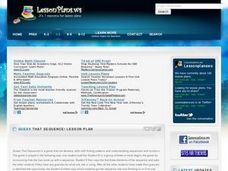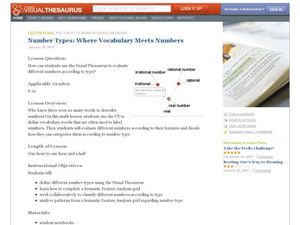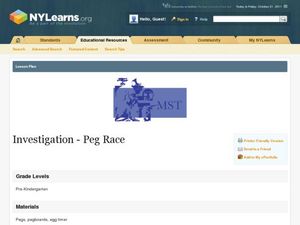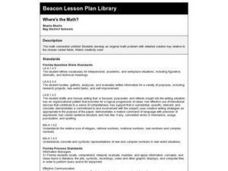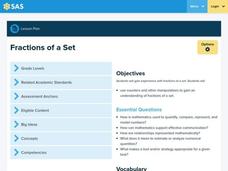Curated OER
Ten by Ten
Learners participate in hands-on activities using a hundreds chart and counting toes and fingers. They discover the patterns that are created when counting by ten. After a lecture/demo, students practice by using a worksheet embedded in...
Curated OER
Guess That Sequence!
Students explore number sense by completing problems in class. In this patterns instructional activity, students examine a group of numbers and identify what the pattern is and how it should correctly continue. Students practice...
Curated OER
Fibonacci Numbers
Students calculate the Fibonacci sequence of numbers. Through the use of Fibonacci numbers in flowers, leaves, fruits, vegetables, pine cones, and other forms of nature; students explore how Fibonacci numbers occur in nature. Then they...
Radford University
Fibonacci is All Around
One ratio to rule them all. Young mathematicians investigate the Fibonacci sequence and the Golden Ratio. To begin the first lesson, they use a spreadsheet to see how the Fibonacci sequence gives the Golden Ratio. The second lesson...
Curated OER
Applied Science - Science and Math Pre Lab
Students find Fibonacci sequences. In this applied Science instructional activity, students solve Fibonacci sequence problems. Students explore the mathematical patterns of objects in nature.
Curated OER
Patterns in Pascal's Triangle
Students examine the patterns that exist in Pascal's Triangle. They explore multiples and factors. Sudents use an applet to create and color the multiples in Pascal's Triangle.
Curated OER
Where Math Meets Poetry
Students identify Fibonacci's sequence of numbers and use the pattern to write poetry with one syllable words. In this math and writing lesson, students identify Fibonacci's sequence of numbers and learn about this early mathematician....
Curated OER
Number Types: Where Vocabulary Meets Numbers
Rational, irrational, real, natural. All these words can refer to numbers. Who knew? Learners use the Visual Thesaurus and a semantic feature analysis grid to examine the different attributes of numbers. Step-by-step instructions for...
Curated OER
Investigation: Peg Race
Learners explore competition by participating in a peg race. In this pattern creation instructional activity, students utilize an egg timer and pegs or colored cubes to create patterns quickly while competing with fellow classmates to...
Curated OER
Where's the Math?
Fourth graders create an original math problem with a detailed solution key relative to their chosen career fields.
Curated OER
The Fibonacci Keyboard- Jazz and Math
Learners demonstrate an understanding of the relationships of the Fibonacci Sequence. They apply the Fibonacci Sequence and find its relationship to a piano keyboard. They explore various relationships between music and the Fibonacci...
Curated OER
I Am Golden
Middle schoolers become familiar with patterns, the Fibonacci Sequence, and the Golden Ratio. They see how many places these occur. They have practical applications for using the calculator and making charts to extend patterns.
Curated OER
Multiplication Magic
Investigate multiplication problem solving strategies by working with base 10 blocks. Learners decompose problems with a Merlin the Magician theme. Multiple resources are provided.
Curated OER
Exploring Roman Numerals
Students investigate the values of a variety of Roman Numerals and compare and contrast the patterns with Arabic numbers. The application, "Numerus" is utilized to lead students through the lesson.
Curated OER
Atlatl Lessons
Fifth graders study math patterns and relationships as well as learn about the heritage of Aboriginal peoples of Saskatchewan. In this patterns and heritage lesson, 5th graders research the daily lives of First Nations People in...
Curated OER
Zero is Our Hero (Grades 6-9)
Students become interactive participants in introductory and practice activities involving positive and negative numbers. After watching a video, students play games together which help them use positive and negative numbers effectively.
Curated OER
Guess That Sequence!
Pupils analyze number sense by participating in a pattern identification activity. In this number sequence lesson, students examine several groups of numbers and identify the sequence in the group before adding on to it. Pupils check...
Curated OER
Tiling the Plane
Students use pattern blocks and triangular grid paper to review shape names, be introduced to the concept of a tiling of the plane, and determine which pattern blocks tile the plane. They are asked: "Have you ever seen a floor or a wall...
Mary Pope Osborne, Classroom Adventures Program
Mummies in the Morning Egyptian pyramids, hieroglyphics
Visit the Magic Treehouse and take your class on a trip through time with a reading of the children's book Mummies in the Morning. Using the story to spark an investigation into Egyptian culture, this literature unit engages...
Curated OER
Squares and Square Roots
Students find patterns relating the lengths of the sides of squares to their areas. In this squares and square roots lesson, students draw squares and find their areas. They estimate the sides of square when given the area. Students use...
Curated OER
Geometry Everywhere; Fractal, Math & Form
Young scholars explore fractal geometry. They do online explorations of fractals to discover applications of fractal geometry for a report.
Curated OER
Metric Meals
Sixth graders investigate metric measurements. In this metric measurement lesson, 6th graders explore mass, capacity, and length. Students examine graduated cylinders and balance scales to obtain measurements. Resources are provided.
Curated OER
Ornithology and Real World Science
Double click that mouse because you just found an amazing instructional activity! This cross-curricular Ornithology instructional activity incorporates literature, writing, reading informational text, data collection, scientific inquiry,...
Pennsylvania Department of Education
Fractions of a Set
Students explore number sense by completing a number set worksheet. In this fractions lesson, students utilize pattern blocks as a visual reference to the fractions they practice identifying. Students read the book Clean-Sweep Campers...

